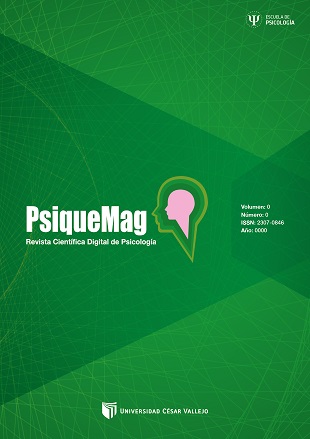Psychometric evidence of the Satisfaction with Life Scale (SWLS) in adult population of Metropolitan Lima, 2020
DOI:
https://doi.org/10.18050/psiquemag.v10i1.2645Keywords:
Pyschometric evidence, Satisfaction with the life, AdultAbstract
The present study was conducted with the aim of analyzing evidence psychometric of the Scale of Satisfaction with Life (SWLS) in adult population of Metropolitan Lima, 2020. We evaluated 314 people, including 166 women and 148 men with an age range between 18 to 59 years. In addition, we applied the type of non-probability sampling by convenience, where people participated voluntarily. On the other hand, we employed the following instruments PANSI, SHS, UCLA to correlate them with the satisfaction. Among the results, evidence of validity was found in relation to other variables; in addition, a total variance of 70% of the instrument was obtained, the adjustment indices (TLI= .997, CFI= .998, RMSEA= .021 and SRMR= .021) indicated the one-dimensional SWLS; consequently, (α= .79 y ω= .80) coefficients demonstrate the reliability of the SWLS scale. In conclusion, the instrument has adequate psychometric evidence for use in the adult population of Metropolitan Lima.
Downloads
References
Abad, F., Olea, J., Ponsoda, V. & García, C. (2011). Medición en ciencias sociales y de la salud. Síntesis.
Arita, B. (2005). Satisfacción por la vida y teoría homeostática del bienestar. Psicología y Salud, 15(1), 2. https://www.redalyc.org/pdf/291/29115113.pdf
Arrindell, W., Heesink, J. & Feij, J. (1999). The Satisfaction With Life Scale (SWLS): appraisal with 1700 healthy young adults in The Netherlands. Personality and Individual Differences, 26(5), 815-826. https://doi.org/10.1016/S0191-8869(98)00180-9
Atienza, F., Pons, D., Balaguer, I. y García-Merita, M. (2000). Propiedades psicométricas de la escala de satisfacción con la vida en adolescentes. Psicothema, 12(2), 314-319. http://www.psicothema.com/psicothema.asp?id=296
Ato, M., López, J. y Benavente, A. (2013). Un sistema de clasificación de los diseños de investigación en psicología. Anales de psicología, 29(3), 1038-1042. http://dx.doi.org/10.6018/analesps.29.3.178511
Bharadwaj, L. & Wilkening, E. (1977). Predicting perceived well-being. Social Indicators Research, 4, 421- 439. https://doi.org/10.1007/BF00353143
Cascaes da Silva, F., Gonçalves, E., Valdivia, B., Bento, G., Silva., T., Soleman H., Salma, S. y Silva, R. (2015). Estimadores de consistencia interna en las investigaciones en salud: el uso del coeficiente alfa. Revista Peruana de Medicina Experimental y Salud Publica, 32(1), 129-138. http://www.scielo.org.pe/scielo.php?script=sci_arttext&pid=S1726-46342015000100019&lng=es&tlng=es.
Castro, A. (2009). El bienestar subjetivo: cuatro décadas de progreso. Revista interuniversitaria de Formación del Profesorado, 23(3), 43-72. https://www.redalyc.org/pdf/274/27419066004.pdf
Caycho, T., Ventura, J., García, C., Barboza, M., Arias, W., Domínguez, J., Azabache, K., Cabrera, I. y Samaniego, A. (2018). Evidencia Psicométrica de la Escala de Satisfacción con la Vida de Diener en adultos mayores peruanos. Revista Ciencias de la Salud, 16(3). https://doi.org/10.12804/revistas.urosario.edu.co/revsalud/a.7267
Cohen, J. (1977). Statistical power analysis for the behavioral sciences (2 ed.). Hillsdale, NJ: Lawrence Erlbaum.
Diener, E., Emmons, R., Larsen, R. & Griffin, S. (1985). The Satisfaction With Life Scale. Journal of Personality Assessment, 49(1), 71–75. http://doi.org/10.1207/s15327752jpa4901_13
Diener, E. & Lucas, R. (1999). Personality and Subjective Well-Being Estados Unidos: New York. https://psycnet.apa.org/record/1999-02842-011
Domínguez, M., Mandujano, M., López, G., Domínguez, R., Gonzáles, M., Sotomayor, M. y Fraijo, B. (2011). Escala de Bienestar Subjetivo en Cuidadores Familiares de Adultos Mayores (EBEMS/CFAM). Revista de psicología, 29(2), 265-287. https://doi.org/10.18800/psico.201102.004
Elosua, P. (2003). Sobre la validez de los tests. Psicothema, 15 (2), 315-321. http://www.psicothema.com/psicothema.asp?id=1063
Elosua, P. y Zumbo, B. (2008). Coeficientes de fiabilidad para escalas de respuesta categórica ordenada. Psicothema, 20 (4), 896-901. http://www.psicothema.com/pdf/3572.pdf
Fernández, P. y Díaz, P. (2000). Significancia estadística y relevancia clínica. Cadena de Atención Primaria, 8, 191-195. https://www.fisterra.com/mbe/investiga/signi_estadi/signi_estadisti2.pdf
Gerbing, D. & Anderson J. (1988). An update paradigm for scale development incorporating unidimentionality and its assessment. Journal of Marketing Research, 25 (2), pp. 186-192. https://www.jstor.org/stable/3172650
Glaesmer, H., Grande, G., Braehler, E. y Roth, M. (2011). The German Version pf the Satisfaction with life Scale (SWLS) Psychometric Properties, Validity and Population-Based Norms. European Journal of Psychological Assessment, 27(2), 127-132. https://doi.org/10.1027/1015-5759/a000058
Gutiérrez, M., Tómas, J., y Jover, A. (2016). Propiedades psicométricas de la satisfaction with life scale en jóvenes angoleños: análisis factorial confirmatorio y modelo de respuesta graduada. Revista Búsqueda, 17(1) 168-179. https://revistas.cecar.edu.co/index.php/Busqueda/article/view/286/268
Glutting, J., Monaghan, M., Adams, W. & Sheslow, D. (2002). Some psychometric properties of a system to measure ADHD Among College Students: Factor Pattern, Reliability, and One-Year Predictive Validity. Measurement and Evaluation in Counseling and Development. 34(4), 194-209. https://doi.org/10.1080/07481756.2002.12069037
Hu, L. & Bentler, P. (1999). Cutoff criteria for fit indexes in covariance structure analysis: Conventional criteria versus new alternatives. Structural Equation Modeling: A Multidisciplinary Journal, 6(1), 1-55. https://doi.org/10.1080/10705519909540118
Huebner, S. (1991). Initial development of the Student’s Life Satisfaction Scale. School Psychology International, 12(3), 231- 240. https://doi.org/10.1177/0143034391123010
Instituto Nacional de Estadística e Informática. (2019). Lima Metropolitana: Población proyecta, según distritos 1995 – 2025. https://www.inei.gob.pe/media/MenuRecursivo/publicaciones_digitales/Est/Lib0012/N53/anexo031.htm
Jurado, P., Soto, M., Concha, M. y Najera, R. (2019). Estructura Factorial de la Escala de Satisfacción con la Vida de Diener en Universitarios Mexicanos. Formación Universitaria 12(6), 183-190. http://dx.doi.org/10.4067/S0718-50062019000600183
Klappenbach, H. (2014). Acerca de la Metodología de Investigación en la Historia de la Psicología. Psykhe, 23(1), 1-12. https://dx.doi.org/10.7764/psykhe.23.1.584
Laca, F., Verdugo, J. y Guzmán, J. (2005). Satisfacción con la vida de algunos colectivos mexicanos: Una discusión sobre la psicología del bienestar subjetivo. Enseñanza e investigación en psicología, 10(2), 325-336. https://www.redalyc.org/articulo.oa?id=29210208
Lloret, S., Ferreres, A., Hernandez, A. & Tomas, I. (2017). The exploratory factor analysis of ítem: guided analysis based on empirical data and software. Anales de Psicología, 33(2), 417-432. http://dx.doi.org/10.6018/analesps.33.2.270211
Lyubomirsky, S. & Ross, L. (1999). Changes in attractiveness of elected, rejected, and precluded alternativies: A comparison of happy and unhappy individuals. Journal of Persnality and Social Pyschology, 76(6), 988-1007. https://doi.org/10.1037/0022-3514.76.6.988
Martínez, P. (2004). Perspectiva temporal futura y satisfacción con la vida a lo largo del ciclo vital. Revista psicológica de la PUCP, 22(2). http://revistas.pucp.edu.pe/index.php/psicologia/article/view/6858/6992
Martínez, R., Hernández, M. y Hernández M. (2014). Psicometría. Alianza. https://www.alianzaeditorial.es/libro/manuales/psicometria-maria-rosario-martinez-arias-9788420664064/
Meneses, J., Barrios, M., Bonillo, A., Cosculluela, A., Lozano, L. y Turbany, J. y Valero, S. (2013). Psicometría. UOC. https://books.google.hn/books?id=2JxuBAAAQBAJ&lpg=PA1&hl=es&pg=PT3#v=onepage&q&f=false
Montero, I. y León, O. (2001). Usos y costumbres metodológicos en la Psicología española: un análisis a través de la vida de Psicothema (1990-1999). Psicothema, 13, 671-677. http://www.psicothema.com/psicothema.asp?id=495
Morales, P. (2009). Análisis de ítems en las pruebas objetivas. Upco. https://educrea.cl/wp-content/uploads/2014/11/19-nov-analisis-de-items-en-las-pruebas-objetivas.pdf
Neugarten, B., Havighurst, R. y Tobin, S. (1961). The Measurement of life satisfaction. Journal of Gerontology, 16(2), 134-143. https://doi.org/10.1093/geronj/16.2.134
Nunnally, J. y Bernstein, I. (1995). Teoría psicométrica. McGraw-Hill. https://www.worldcat.org/title/teoria-psicometrica/oclc/503283916
Oliver, A., Galiana, L. y Bustos, V. (2018). Validación de la Escala de Satisfacción con la Vida y su relación con las dimensiones del autoconcepto en universitarios peruanos. Persona, 21(2), 1-12. https://www.redalyc.org/jatsRepo/1471/147158511002/147158511002.pdf
Oliveira, E., Dolores, M., Privado, J. y Almeida, L, (2017). Escala de Funcionamento Psicológico Positivo: Adaptação e Estudos Iniciais de Validação em Universitários portugueses. Revista Liboamericana de Diagnóstico y Evaluación, 48(3), 151-162. https://www.aidep.org/sites/default/files/2018-07/RIDEP48-Art13.pdf
Ortiz, M., Gancedo, K. y Reyna, C. (2013). Propiedades psicometricas de la escala de felicidad subjetiva en jòvenes y adultos de la ciudad de Còrdoba-Argentina. Suma Psicològica, 20, 45-56. http://www.scielo.org.co/pdf/sumps/v20n1/v20n1a04.pdf
Osman, A., Gutierrez, P., Kopper, B., Barrios, F. y Chiros, C. (1998). The Positive and Negative Suicide Ideation Inventory Development and Validation. Psychological Reports, 82, 783-793. https://journals.sagepub.com/doi/abs/10.2466/pr0.1998.82.3.783
Otzen, T. y Manterola, C. (2017). Técnicas de Muestreo sobre una Población a Estudio. International Journal of Morphology, 35(1), 227-232. http://dx.doi.org/10.4067/S0717-95022017000100037
Pavot, W. y Diener, E. (1993). Review of the Satisfaction with Life Scale. Psychological Assessment, 5(2), 164-172. http://internal.psychology.illinois.edu/~ediener/Documents/Pavot-Diener_1993.pdf
Pavot, W., Diener, E., Colvin, C. y Sandvik, E. (1991). Further validation of the Satisfaction With Life Scale: Evidence for the cross-method convergence of well-being. Social Indicators Research, 28, 150. https://www.researchgate.net/publication/21236018_Further_Validation_of_the_Satisfaction_With_Life_Scale_Evidence_for_the_Cross-Method_Convergence_of_Well-Being_Measures
Prieto, G. y Delgado, A. (2010). Fiabilidad y validez. Papeles del Psicólogo, 31(1), 67-74. http://www.papelesdelpsicologo.es/pdf/1797.pdf
Puig, M., Rodríguez, N., Farras, J. y Lluch, M. (2011). Calidad de vida, felicidad y satisfacción con la vida en personas ancianas de 75 años atendidas en un programa de atención domiciliaria. Revista Latino-am, 18(3). https://www.scielo.br/pdf/rlae/v19n3/es_04.pdf
Real Academia Española [RAE]. (2020). Satisfacción. En Diccionario de la lengua española (23.ª ed.). https://dle.rae.es/satisfacci%C3%B3n?m=form
Real Academia Española [RAE]. (2020). Vida. En Diccionario de la lengua española (23.ª ed.). https://dle.rae.es/vida?m=form
Robert, W., Pinheiro, E., Vieira, M., Melo G. & Luiz F. (2018). Psychometric properties of satisfaction with life scale in the Brazilian Sports context. Bras Med Esporte, 24(1), 45-46. https://www.scielo.br/scielo.php?pid=S1517-86922018000100045&script=sci_abstract&tlng=pt
Russell, D., Peplau, L. & Ferguson, M. (1978). Developing a Measure of Loneliness. Journal of Personality Assessment, 42(3), 290-194. https://www.researchgate.net/publication/22482710_Developing_a_Measure_of_Loneliness
Ryff, C. y Singer, B. (1998). Los contornos de la salud humana positiva. Consulta psicológica, 9(1), 1–28. https://doi.org/10.1207/s15327965pli0901_1
Sachs, J. (2004). Validación de la escala de satisfacción con la vida en una muestra de estudiantes universitarios de Hong Kong. Psychologia: An International Journal of Psychology in the Orient, 46(4), 225-234. http://www.scielo.org.pe/scielo.php?script=sci_nlinks&ref=418763&pid=S1729-4827201800020000600081&lng=es
Schmidt, V., Raimundi, M. y Molina, M. (2015). Satisfacción vital en dominios específicos: adaptación de una escala para su evaluación. Liberabit, 21(2), 299-312. http://www.scielo.org.pe/scielo.php?script=sci_arttext&pid=S1729-48272015000200012&lng=es&tlng=es.
Schreiber, J., Nora, A., Stage, F., Barlow, E. & King, J. (2006). Reporting structural equation modeling and confirmatory factor analysis results: a review. The Journal of Educational Research, 99(6), 323-338. https://www.researchgate.net/publication/254345399_Reporting_Structural_Equation_Modeling_and_Confirmatory_Factor_Analysis_Results_A_Review
Seligman, M. y Csikszentmihalyi, M. (2000). Psicología positiva: una introducción. Psicólogo estadounidense, 55(1) 5-14. https://psycnet.apa.org/record/2000-13324-001
Shin, D. & Johnson, D. (1978). Avowed happiness as an overall assessment of the quality of life. Social Indicators Research, 5, 478. https://www.researchgate.net/publication/226630304_Avowed_happiness_as_an_overall_assessment_of_the_quality_of_life
Tian, L., Wang, D. & Huebner, E. (2015). Development and validation of the Brief Adolescents’ Subjective Well-Being in School Scale (BASWBSS). Social Indicators Research, 120(2), 615-634. https://www.researchgate.net/publication/271951844_Development_and_validation_of_the_Brief_Adolescents_Subjective_Well-Being_in_School_Scale_BASWBSS
Tornimbeni, S., Pérez, E. y Olaz, F. (2008). Introducción a la psicometría. Paidós.
Vásquez, C., Duque, A. & Hervás, G. (2013). Satisfaction with Life Scale in a Representative Sample of Spanish Adults: Validation and Normative Data. The Spanish Journal of Psychology, 16, 1-15. https://www.researchgate.net/profile/Carmelo_Vazquez2/publication/258526489_Satisfaction_with_Life_Scale_in_a_Representative_Sample_of_Spanish_Adults_Validation_and_Normative_Data/links/00b495285282780945000000/Satisfaction-with-Life-Scale-in-a-Representative-Sample-of-Spanish-Adults-Validation-and-Normative-Data.pdf
Vàzquez, A. y Garcìa , R. (1994). RULS: Escala de soledad UCLA Revisada. Fiabilidad y validez de una version española. Revista de Psicologia de la Salud, 6, 45-54. https://rua.ua.es/dspace/bitstream/10045/97430/1/RevPsicolSalud_6_1_03.pdf
Veenhoven, R. (1994). El estudio de la satisfacción con la vida. Intervención psicosocial, 3, 4. https://repub.eur.nl/pub/16195/
Velásquez, C., Dioses, A., Chávez, J., Pomalaya, R., Cavero, V., Cabrera, S., Velásquez, N. y Egúsquiza, B. (2016). Personalidad y satisfacción por áreas vitales en estudiantes de Psicologia de la universidad pública de Lima. IIPSI. 19(1), 81-97. https://revistasinvestigacion.unmsm.edu.pe/index.php/psico/article/view/12446/11137
Ventura, J. y Caycho, T. (2017). El coeficiente Omega: un método alternativo para la estimación de la confiabilidad. Revista Latinoamericana de Ciencias Sociales, Niñez y Juventud, 15 (1), 625-627. https://www.redalyc.org/pdf/773/77349627039.pdf
Viladrich, C., Angulo-Brunet, A., y Doval, E. (2017). A journey around alpha and omega to estimate internal consistency reliability. Anales de Psicología, 33(3), 755-782. https://dx.doi.org/10.6018/analesps.33.3.268401
Villalobos , F. (2010). Validez y fiabilidad del Inventario de Ideación Suicida Positiva y Negativa-PANSI, en estudiantes colombianos. Universitas Pyschologica, 9(2), 509-520. HYPERLINK. http://www.scielo.org.co/pdf/rups/v9n2/v9n2a17.pdf
Downloads
Published
Issue
Section
License
Copyright (c) 2021 PsiqueMag

This work is licensed under a Creative Commons Attribution-NonCommercial-NoDerivatives 4.0 International License.
You are free to:
- Share — copy and redistribute the material in any medium or format
- The licensor cannot revoke these freedoms as long as you follow the license terms.
Under the following terms:
-
Attribution — You must give appropriate credit, provide a link to the license, and indicate if changes were made. You may do so in any reasonable manner, but not in any way that suggests the licensor endorses you or your use.












